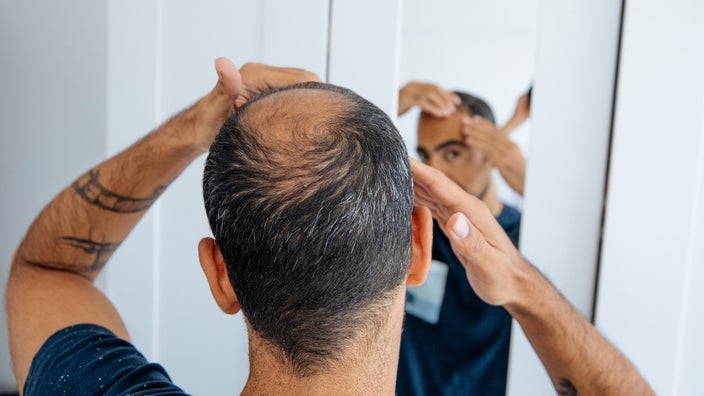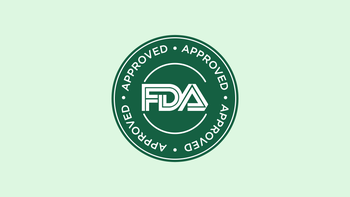
9 Telltale Signs Your Testosterone Levels Are Low
Key takeaways:
Testosterone is a sex hormone important for male and female health. In men, testosterone plays a key role in muscle growth, bone strength, sex drive, sperm production, and more.
Symptoms of low testosterone in men include erectile dysfunction, hair loss, low sex drive, and low energy. A healthcare professional can check your testosterone levels with a blood test and treat people with low levels.
Low testosterone in men is common and is most often caused by aging. Other causes include issues with the testicles making testosterone or hormonal conditions.
Table of contents

Testosterone is a hormone that both men and women make naturally. It’s especially important for male sexual health and overall well-being. As you get older, it’s normal for testosterone levels to drop. Low testosterone levels (called “low T” for short) can affect up to 40% of all men — with the incidence increasing with age. Low T symptoms can include erectile dysfunction, low fertility, and even osteoporosis. But sometimes there are no symptoms at all.
The good news is that treatment is usually pretty straightforward. Here’s what you need to know about causes of low T, early symptoms, and treatment options.
What does testosterone do in the male body?
Testosterone is a sex hormone. It’s involved in many aspects of male health, including:
Puberty and male sexual development
Sex drive
Bone strength
Muscle growth
Red blood cell production
Energy and mood
Having low testosterone levels can affect all these functions.
What causes low testosterone levels?
There are many causes of low testosterone. The most common cause is normal aging. Testosterone levels drop a little bit each year as you get older.
Less common causes can be broadly separated into two types: primary and secondary. Let’s take a look at these below.
What’s a “normal” sex drive? Find out what factors can affect your libido and what you can do about it.
Treating Low T: Discover the treatment options available for treating low testosterone levels.
Testosterone replacement side effects: Learn more about the risks of testosterone replacement therapy for low testosterone levels.
Primary low testosterone
This refers to a problem in the testicles themselves. Since testicles make testosterone, any conditions that affect how they work can affect how much testosterone you make. Causes of primary low testosterone include:
Infections, like mumps
Klinefelter syndrome
Testicular torsion
Radiation treatment
Human immunodeficiency virus (HIV)
Liver cirrhosis and liver failure
Physical injury to the testicles, like from a car accident or sports injury
Secondary low testosterone
This is when your testicles work normally, but other health problems stop you from making testosterone. Aging is one example of secondary low testosterone.
Other examples include:
Brain tumors or other problems in the pituitary gland (a gland in your brain that regulates many hormones)
Hormone-blocking treatment (used for prostate cancer, among other conditions)
Long-term use of opioid pain medications
Low testosterone symptoms in men
Many men don’t notice symptoms of age-related low testosterone because it happens gradually. But some people do have symptoms — especially if a medical condition or treatment causes low T to happen suddenly.
Here are nine common symptoms of low testosterone in men.
1. Hair loss
Hair loss, whether on your face or body, is a visible sign of low T. Testosterone helps maintain facial and body hair. If your hair suddenly thins or seems to disappear, it could be a clue that your testosterone levels are getting low.
2. Low sex drive
Testosterone creates a healthy sex drive in both men and women. If you notice your libido starting to decline and there are no obvious explanations (like stress, traumatic events, or lack of sleep), make an appointment with a healthcare professional. They can help narrow down the cause and find out whether low T might be behind your symptoms.
3. Erectile dysfunction
Erectile dysfunction (ED) is a classic symptom of low testosterone and is often accompanied by low sex drive. If your sex drive is low, having and maintaining an erection can become difficult. While most cases of ED are due to other health problems, low testosterone can also affect your sexual performance.
4. Infertility
Low testosterone can cause infertility, as well. This is because testosterone is one of the main hormones needed to create sperm. Low testosterone levels mean low sperm counts. And some men with low T produce no sperm at all.
You would need a healthcare professional to confirm this. But if you and your partner are having trouble conceiving, you may want to have your testosterone levels checked.
5. Osteoporosis
When your testosterone levels are adequate, some of the testosterone is transformed into estrogen to help protect your bones. But when you have low testosterone levels, your body doesn’t do this. This leads to your bones becoming weak and more likely to break.
Low bone mineral density and osteoporosis from low T are most concerning in men over 65, but all men should be aware of this risk.
6. Low muscle mass
Testosterone is the most important hormone for muscle growth. When your testosterone levels are low, your existing muscle mass will start to shrink. A healthcare professional will typically look for this if they’re concerned you may have low T.
7. Mood swings and irritability
Feeling depressed or more emotional can be an issue for men with low testosterone levels. A healthy level of testosterone helps keep your mood in check.
Because mood swings can be caused by many other health issues, it may be difficult to know whether low T is causing them. It’s best to talk to a healthcare professional if you have any sudden mood changes that you can’t explain.
8. Fatigue and difficulty concentrating
Healthy levels of testosterone help you feel energized. One of the biggest complaints among men with low testosterone is that they feel tired and unfocused, no matter how much they sleep. If you have fatigue that lasts for weeks and can’t be explained by stress or extreme activity, talk with a healthcare professional.
9. Hot flashes
Hot flashes are commonly associated with menopause, but men can also have them. Hot flashes usually only happen in men who have gone through chemotherapy and have almost no testosterone left in their bodies. While experts don’t know why this happens, if you’re having hot flashes, it’s important that you share this with a healthcare professional. They can help you pinpoint whether low T may be causing it.
Other signs of low T
There are a few other signs of low testosterone outside of the main symptoms we’ve discussed.
The type of low T symptoms you experience may depend on when the low T developed. For example, if you have low T before puberty, your testes and penis may not fully develop. And you may not have as deep of a voice.
Some men with low T may also start growing breast tissue, known as gynecomastia. Let a healthcare professional know if you notice any new symptoms.
How to tell if you have low testosterone
By running a simple blood test, a healthcare professional will be able to see if you have abnormal levels of testosterone. Testosterone in your blood should be between 300 ng/dL and 1,000 ng/dL. This can change depending on your age.
You’ll also likely have a physical exam to check your hair growth, muscle growth, and the size and appearance of your testicles. If you have a health condition (like diabetes or HIV) that is more likely to cause low T, you may have these blood tests and exams during your regular checkups.
Low testosterone treatment
Treating low testosterone is pretty straightforward: In general, the goal is to replace what’s missing. But not all men with low testosterone need treatment. If your testosterone levels are gradually declining with age and symptoms aren’t a problem for you, then treatment isn’t necessary.
For younger men with low testosterone or older men with abnormally low levels, testosterone replacement therapy is available in many different forms. While receiving treatment with any of these options, you’ll need to have regular blood work done to monitor your testosterone levels and make sure they’re balanced.
Keep in mind that testosterone treatment options are also Schedule III controlled substances. In other words, they’re medications that come with a low to moderate risk of dependence. Testosterone replacement therapy may also raise the risk of prostate cancer, heart attacks, and strokes in older men.
Below are different treatment options commonly prescribed for low testosterone.
Treatment option | Where applied | Frequency |
Varies depending on the product | Once a day | |
A clean, dry area of skin | Once a day | |
Injected into the buttocks muscle like a regular shot | Every 2-4 weeks by a healthcare professional or self-administered at home | |
Nostril | 3 times a day (don’t blow your nose for an hour afterward) | |
Implanted just beneath the skin of your upper arm by a healthcare professional | Every 3-6 months |
Depending on where you live, you might be able to get a testosterone testing kit. You can use it to monitor your testosterone levels while you’re undergoing therapy.
How can I raise my testosterone levels naturally?
There are a few natural ways to treat low testosterone. For example, exercise is an effective way to raise testosterone levels. Research shows that men who exercise regularly have better testosterone function.
Eating healthy, well-balanced meals can also help. Diets high in fat are associated with lower testosterone levels. Also, if you have low vitamin D levels, taking a vitamin D supplement can raise your testosterone. One study in men with excess weight showed that taking 83 mcg of vitamin D for a year led to a significant increase in testosterone levels.
Lastly, getting a good night’s sleep may help. A small study found that just 1 week of sleep deprivation can lower testosterone levels by 10% to 15%. In comparison, the rate at which testosterone lowers each year with age is only 1% to 2%.
What happens if low testosterone goes untreated?
It’s possible that the gradual decline of testosterone with age is responsible for the effects of aging that men experience. But, for most men, testosterone replacement therapy isn’t necessary.
For younger men with low testosterone or older men with abnormally low levels, untreated low testosterone can lead to medical complications. Infertility is a significant issue for many men with low T.
Bone thinning and muscle weakness from low testosterone can be especially problematic for older men. Thin bones are more likely to break. Combined with muscle weakness, recovering and caring for yourself can be difficult.
If you think you may have low T, talk to a healthcare professional to understand your treatment options and next steps.
Frequently asked questions
Eating healthy foods like whole grains, fresh vegetables, and legumes can help increase testosterone levels. Avoiding refined sugars, dairy, and processed, packaged foods is equally important. A balanced diet is important in maintaining normal testosterone levels at any age.
If your testosterone levels are in the normal range and you’re otherwise healthy, you should feel like you have enough energy to get through the day. Other signs include a normal libido, stable mood, ability to achieve an erection, and clear thinking.
A review of the published data looking at supplements claiming to boost testosterone gave disappointing results:
Less than 25% of supplements had data to show an increase in testosterone
About 10% actually lowered testosterone, and almost 20% showed no difference
Around 40% gave no data at all
Zinc, vitamin B12, and vitamin B6 are thought to improve testosterone, but many supplements contain levels much higher than the FDA recommends. Always talk to a healthcare professional first before taking any supplements.
The bottom line
Low testosterone (low T) affects many men. The good news is that low T is usually simple to treat. If you’re experiencing symptoms such as low libido, fatigue, or mood swings that can’t be explained, talk with a healthcare professional. They can test your testosterone levels and help you develop a treatment plan that works for you.
Why trust our experts?



References
Anaissie, J., et al. (2017). Testosterone deficiency in adults and corresponding treatment patterns across the globe. Translational Andrology and Urology.
Bhasin, S., et al. (2018). Testosterone therapy in men with hypogonadism: An Endocrine society clinical practice guideline. The Journal of Clinical Endocrinology and Metabolism.
Bishop, D. T., et al. (1988). The effect of nutritional factors on sex hormone levels in male twins. Genetic Epidemiology.
Clemesha, C. G., et al. (2020). ’Testosterone boosting’ supplements composition and claims are not supported by the academic literature. The World Journal Of Men’s Health.
Corsetti, V., et al. (2023). Effects of the low-carb organic Mediterranean diet on testosterone levels and sperm DNA fragmentation. Current Research in Food Science.
Endocrine Society. (2022). Gynecomastia.
Fainberg, J., et al. (2019). Recent advances in understanding and managing male infertility. F1000Research.
Feldman, H. A., et al. (2002). Age trends in the level of serum testosterone and other hormones in middle-aged men: Longitudinal results from the Massachusetts male aging study. The Journal of Clinical Endocrinology and Metabolism.
Kelly, D. M., et al. (2013). Testosterone: A metabolic hormone in health and disease. The Journal of Endocrinology.
Leproult, R., et al. (2011). Effect of 1 week of sleep restriction on testosterone levels in young healthy men. JAMA.
Pilz, S., et al. (2011). Effect of vitamin D supplementation on testosterone levels in men. Hormone and Metabolic Research.
Qaseem, A., et al. (2020). Testosterone treatment in adult men with age-related low testosterone: A clinical guideline from the American College of Physicians. Annals of Internal Medicine.
Schmidt, P. J., et al. (2004). The effects of pharmacologically induced hypogonadism on mood in healthy men. Archives of General Psychiatry.
Vaamonde, D., et al. (2012). Physically active men show better semen parameters and hormone values than sedentary men. European Journal of Applied Physiology.




